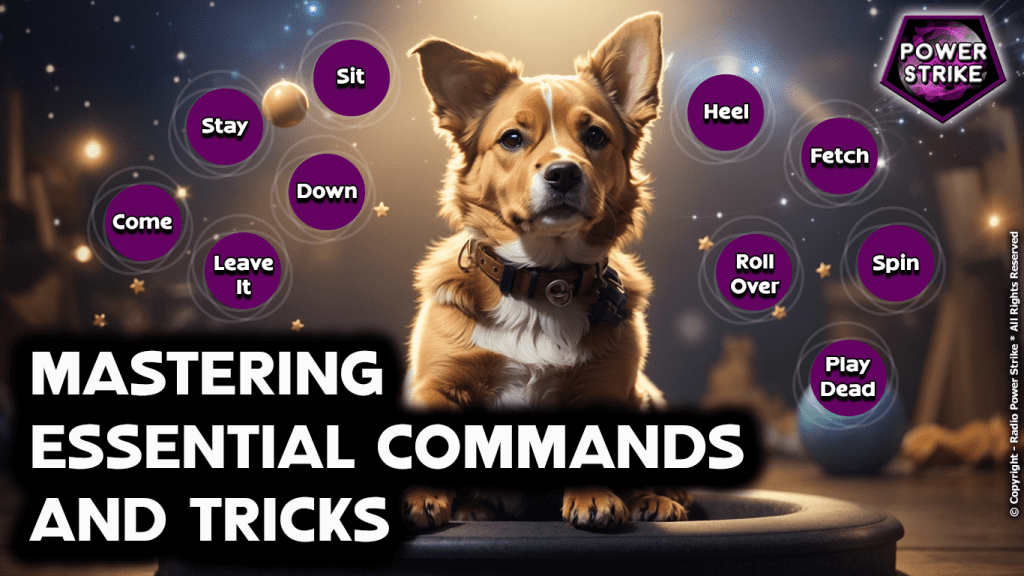A Complete Guide to Pet Training: From Basic Commands to Advanced Tricks
Mastering Essential Commands and Tricks for a Well-Behaved Pet

Discover the top 10 pet training commands and tricks, from the basics to the advanced, and learn how to effectively train your pet for a harmonious relationship.
Training your pet is an essential part of responsible pet ownership. It not only helps in managing your pet’s behavior but also strengthens the bond between you and your pet. From basic commands to advanced tricks, training can be a fun and rewarding experience for both you and your pet. In this guide, we will explore the top 10 pet training commands and tricks that every pet owner should know.

1- Sit Command
The “Sit” command is one of the most basic and essential commands in pet training. It is the foundation for many other commands and tricks, and it is often the first command taught to pets.
To teach the “Sit” command, hold a treat close to your pet’s nose and then move your hand up, allowing their head to follow the treat and causing their bottom to lower. Once they’re in sitting position, say “Sit,” give them the treat, and share affection.
This command is particularly useful in instilling good manners in your pet. It can help manage their behavior and prevent them from jumping up on people or running out the door.
2- Stay Command
The “Stay” command is crucial for keeping your pet safe and well-behaved. It instructs your pet to remain in their current place and position until given further instructions.
To teach the “Stay” command, ask your pet to “Sit.” Then, open the palm of your hand in front of you, and say “Stay.” Take a few steps back. If your pet stays, give them the treat and some affection. Gradually increase the number of steps you take before giving the treat.
The “Stay” command is especially useful in situations where you need your pet to remain calm and stationary, such as during vet visits or when guests arrive.
3- Down Command
The “Down” command is a more submissive position for your pet and is useful in situations where you need them to be calm and relaxed.
To teach the “Down” command, find a particularly good-smelling treat, and hold it in your closed fist. Hold your hand up to your pet’s snout. When they sniff it, move your hand to the floor, so they follow. Then slide your hand along the ground in front of them to encourage their body to follow their head. Once they’re in the down position, say “Down,” give them the treat, and share affection.
The “Down” command can be useful in various situations, such as during meal times or when you’re at a café or park.
4- Come Command
The “Come” command is essential for ensuring your pet’s safety. It allows you to keep your pet close and prevent them from running off in potentially dangerous situations.
To teach the “Come” command, put a leash and collar on your pet. Go down to their level and say, “Come,” while gently pulling on the leash. When they get to you, reward them with affection and a treat.
This command is particularly important in outdoor environments, where there’s a risk of your pet running off and getting lost or injured.
5- Leave It Command
The “Leave It” command is used to prevent your pet from picking up or engaging with something you don’t want them to. This could be anything from food on the street to a potentially dangerous object.
To teach the “Leave It” command, hold a treat in both hands. Show your pet one closed fist with the treat inside and say, “Leave it.” Your pet will likely try to get the treat, sniffing, pawing, and even barking. Once they stop trying and pull away, say “Good leave it,” and give them the treat from the other hand. Repeat until your pet moves away from the first fist when you say, “Leave it.”
This command is especially useful in keeping your pet safe from potentially harmful substances or objects. It’s important to practice this command in various situations to ensure your pet understands it fully.
6- Heel Command
The “Heel” command is used to keep your pet close to you during walks, especially in crowded or high-traffic areas. It’s a way to ensure your pet’s safety and good behavior when out and about.
To teach the “Heel” command, have your pet sit next to you on your left side. With a treat in your left hand, say “Heel,” and start walking forward. If your pet stays next to you, give them the treat and praise. If they pull ahead or lag behind, stop and guide them back to the correct position next to you before continuing.
The “Heel” command requires patience and consistency, as it may take some time for your pet to understand the concept. However, with regular practice, your pet will learn to walk calmly by your side.
7- Fetch Command
The “Fetch” command is a fun and interactive way to engage with your pet. It’s not only a game but also a training exercise that teaches your pet to follow commands and return to you.
To teach the “Fetch” command, start with a toy that your pet likes. Throw the toy a short distance and say “Fetch.” When your pet goes after the toy, call them back with the “Come” command. When they return to you with the toy, say “Drop it,” and reward them with a treat when they do.
The “Fetch” command is a great way to exercise your pet and reinforce the “Come” and “Drop it” commands. It’s also a fun way to strengthen your bond with your pet.
8- Roll Over Command
The “Roll Over” command is an advanced trick that can be a fun challenge for your pet. It’s a way to engage your pet’s mind and body and show off their training skills.
To teach the “Roll Over” command, have your pet start in a “Down” position. Hold a treat near their nose and slowly move it towards their shoulder, guiding them to roll over onto their back. As they complete the roll, say “Roll Over,” give them the treat, and praise them.
The “Roll Over” command requires patience and practice. It’s important to take it slow and make the training process a positive experience for your pet.
9- Play Dead Command
The “Play Dead” command is another advanced trick that can be entertaining and impressive. It’s a way to stimulate your pet’s mind and showcase their obedience training.
To teach the “Play Dead” command, have your pet start in a “Down” position. Hold a treat near their nose and slowly move it towards their side, guiding them to roll over onto their back. As they lie still, say “Play Dead,” give them the treat, and praise them.
The “Play Dead” command can be a fun challenge for your pet. Remember to keep training sessions short and positive, and always reward your pet for their success.
10- Spin Command
The “Spin” command is a fun and simple trick that can add variety to your pet’s training routine. It’s a way to keep training sessions exciting and engaging for your pet.
To teach the “Spin” command, hold a treat near your pet’s nose and guide them in a circular motion. As they follow the treat and complete the spin, say “Spin,” give them the treat, and praise them.
The “Spin” command is a great way to engage your pet’s mind and body. It’s a simple trick that can be taught in short training sessions, making it a fun and rewarding experience for both you and your pet.

Remember, training should be a fun and rewarding experience for both you and your pet. Always use positive reinforcement and be patient. Happy training!

Comments are closed, but trackbacks and pingbacks are open.